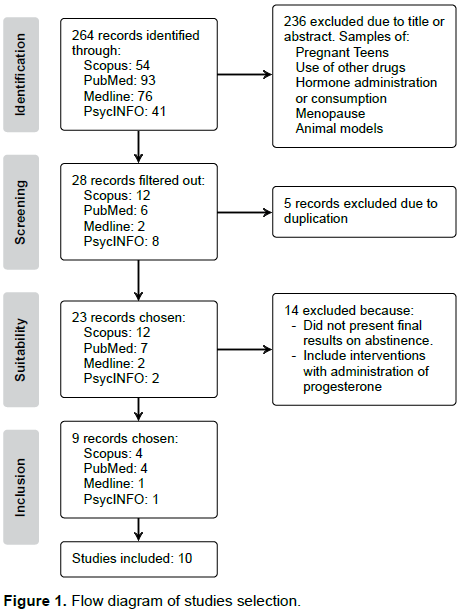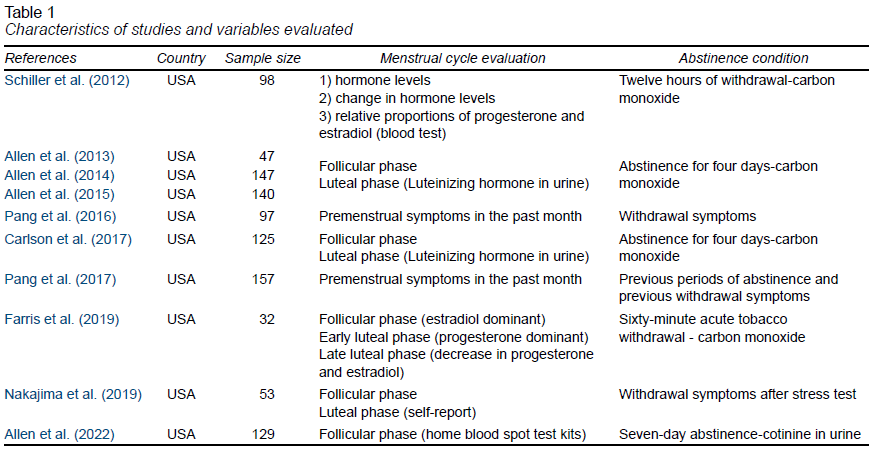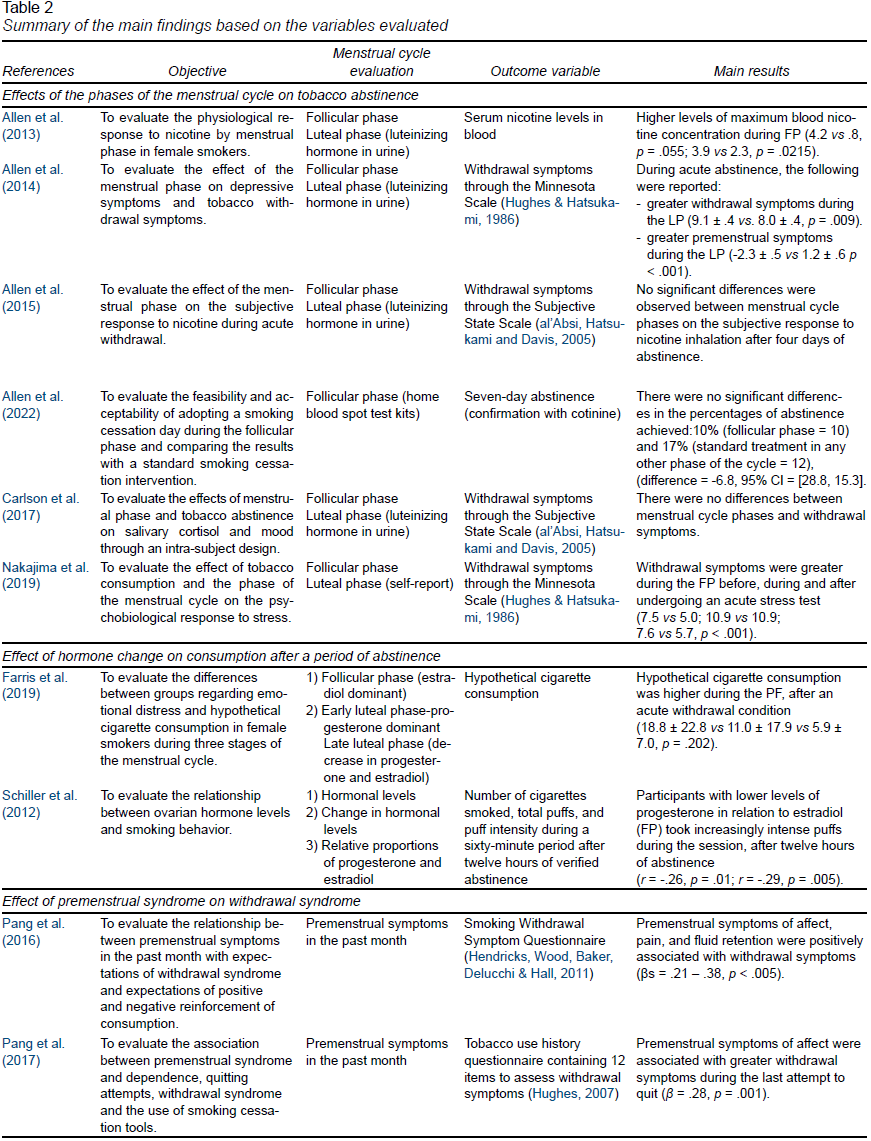BACKGROUND
Tobacco consumption is considered the leading preventable cause of death in the world (World Health Organization [WHO], 2018), which is why efforts are being made to design increasingly effective interventions to help smokers quit. According to the WHO (Allen, Allen, Lunos, & Pomerleau, 2010), it is necessary to identify the sex-related obstacles encountered when quitting smoking. In the case of women, it has been found that hormone changes during the menstrual cycle influence the variables related to quitting smoking at a physiological and psychological level.
Variables influencing smoking cessation treatments include age, sex, exposure to other smokers at home, high levels of dependence, more severe withdrawal symptoms, low level of self-efficacy and comorbidity with other disorders (Ditre, Zale & Brandon, 2015).
Women have less favorable treatment outcomes since they benefit less from nicotine replacement therapies (Perkins, 2001) and suffer more side effects such as constipation, reduced sleep, and weight loss with pharmacological therapies such as varenicline. Moreover, when they receive brief advice to quit smoking, they experience more difficulty maintaining abstinence in the first 24 hours than men (Castaldelli-Maia, Nesoff, Lima, Sanchez, & Martins, 2022; Castellani, Gonçalves, Castaldelli-Maia, & Malbergier, 2020).
Variables that make it difficult to achieve abstinence in the case of women include weight gain, greater negative affect, as well as the presence of stress, anxiety, and depression (Sieminska & Jassem, 2014). These variables, in turn, are influenced by changes during the menstrual cycle, meaning that in addition to experiencing the discomfort characteristic of abstinence, women will also experience physical and psychological changes that occur during the menstrual cycle, such as premenstrual syndrome, making it difficult to quit smoking (Wetherill, Franklin, & Allen, 2016).
The menstrual cycle has an average duration of twenty-eight days and is divided into two phases: the proliferative phase (from day 0 to 14) and the secretory phase (from day 14 to 28). The hormonal changes that occur during the menstrual cycle can be divided into three phases: The early follicular phase occurs from day one to four and is characterized by low levels of the hormones (progesterone and estradiol). The late follicular phase occurs until day 14 and is characterized by a peak in estradiol levels and finally, in the mid luteal phase, progesterone peaks and ends on approximately day 28 (Allen et al., 2016; McNulty et al., 2020).
O’Dell and Torres (2014) explain that in regard to the impact of hormone changes on smoking behavior, during the follicular phase of the menstrual cycle, when estrogen interacts with nicotine, there is an increase in the positive reinforcement obtained by smoking. Conversely, progesterone reduces the rewarding effect of nicotine. In this respect, one study found that when women attempt to quit smoking during the second phase of the menstrual cycle (the luteal phase, from approximately day 14 to 28 of the menstrual cycle), more severe withdrawal symptoms are experienced than in the first phase (follicular phase, from approximately day one to day 14 of the menstrual cycle), probably because premenstrual syndrome is experienced during the second phase (Lynch & Sofuoglu, 2010).
When withdrawal symptoms have been evaluated in the menstrual cycle phases, they have been found to be more intense during the luteal phase, although more cravings for smoking are experienced during the follicular phase (Sieminska & Jassem, 2014).
Allen et al. (2010) examined the association between withdrawal symptoms and attempts to quit smoking during the two stages of the menstrual cycle. They found that premenstrual and withdrawal symptoms were significantly more intense during the luteal phase. However, those who attempted to quit smoking during the follicular phase had more nicotine cravings and a greater likelihood of relapse at fourteen days.
The menstrual cycle influences withdrawal symptoms and the desire to smoke, but the effect of the phases of the menstrual cycle on the maintenance of abstinence have yet to be clarified. Having this information would contribute to decision-making in interventions for women wishing to quit smoking, for example, by identifying the phase of the menstrual cycle when women can achieve better results in quitting smoking.
Given the above, the purpose of this review was to identify the evidence related to the effect of the menstrual cycle on tobacco abstinence, considering the variable phases of the cycle, hormone levels, and premenstrual syndrome.
METHOD
Search strategy
A literature search was conducted in July 2022, in the Scopus, PubMed, MEDLINE, and PsycINFO databases. Controlled MESH vocabulary and thesauruses were used for each search, as shown below: ([smoking cessation] AND [menstrual cycle]) OR (premenstrual syndrome). All records published between 2012 and 2022 in the areas of medicine and psychology were retrieved, regardless of the language in which they were written.
This search strategy adhered to the PRISMA criteria for scoping reviews (Tricco et al., 2018), stating that they must clearly specify the question and objectives of the review, the eligibility criteria, databases used, search and selection strategy, definition of the variables analyzed, method used for evaluation and synthesis of the results, critical evaluation of the evidence, discussion, and conclusion.
Inclusion and exclusion criteria
The authors included studies that compared the phases of the menstrual cycle, and hormone levels or evaluated the relationship between premenstrual syndrome and a withdrawal condition. Randomized and non-randomized clinical trials and randomized controlled trials were considered. Studies were included when the samples comprised women ages 18 to 40, with regular menstrual cycles, who had smoked regularly in the past two years.
Studies that included pregnant women, women who used other drugs, hormonal or contraceptive products, or had medical and psychiatric comorbidities, were menopausal or had premenstrual dysphoric disorder were not considered, because this could have biased their effect on abstinence.
Outcome Measures
The outcome measures considered were those that reflected an abstinence condition, such as the length of abstinence, post-abstinence consumption, and withdrawal symptoms. It did not matter whether or not participants were undergoing smoking cessation treatment.
Since articles had to meet the criteria of including abstinence and determining the stage of the women’s menstrual cycle, each article was individually selected and reviewed. Figure 1 shows the selection criteria and the cause of their elimination in each phase in keeping with the PRISMA criteria.
RESULTS
Ten studies evaluating a condition associated with the menstrual cycle were included. Two evaluated premenstrual symptoms, two the hormone changes between progesterone and estradiol while the remainder compared the follicular (FP) and luteal (LP) phases of the menstrual cycle. In all cases, verified abstinence was a requirement for subsequently evaluating the variables of interest (Table 1).
Given that the primary outcome variables and the design used were different in each study analyzed, a narrative synthesis of the results was conducted. Table 2 shows the main results.
Effect of the phases of the menstrual cycle on tobacco abstinence
Among the studies included, six considered the menstrual cycle phases as an independent variable.
The study by Allen et al. (2013) found that after a period of acute withdrawal (seven days of abstinence were requested), when subjects inhaled nicotine for 60 minutes with a spray, the peak blood nicotine concentration was significantly higher during the FP.
Nakajima, Allen, and al’Absi, (2019) analyzed withdrawal symptoms before, during, and after an acute stress test, finding that they were greater during the FP. Conversely, Allen et al. (2014) evaluated withdrawal and premenstrual symptoms, as well as perceived stress, and found that they were greater during the LP. The presence of more intense levels of withdrawal symptoms and perceived stress during the LP could be explained by the presence of premenstrual symptoms.
No differences were found between the phases of the cycle evaluated for the subjective response to nicotine, understood as the incentive and desire to smoke (Allen et al., 2015), abstinence rates, salivary cortisol, and mood (Allen et al., 2022; Carlson, Allen, Allen, & al’Absi, 2017).
Effect of hormonal change on consumption after a period of abstinence
Two of the studies (Farris, Abrantes, & Zvolensky, 2019; Schiller, Saladin, Gray, Hartwell, & Carpenter, 2012) considered changes in hormone levels during the menstrual cycle as an independent variable.
It was observed that hypothetical consumption (subjects were asked how many cigarettes they would smoke if they cost different prices) and the number and intensity of puffs taken on a cigarette after a period of abstinence were greater during the FP, when the level of estradiol is higher in proportion to progesterone.
Effect of premenstrual syndrome on withdrawal syndrome
In addition to the studies comparing menstrual cycle phases, another two studies were found that evaluated the relationship between premenstrual syndrome and withdrawal syndrome.
Pang et al. (2016) and Pang, Andrabi, and Leventhal (2017) agree that there is a positive relationship between PMS, particularly mood-related symptoms, and withdrawal symptoms.
Given that the studies analyzed used different research designs, in keeping with the STROBE statement (Strengthening the Reporting of Observational Studies in Epidemiology; Von Elm et al., 2008), which provides guidelines for evaluating the quality of information in cross-sectional studies with case-control, it was found that most studies have deficiencies in the specification of the sample size, information on missing data, the way the sample was recruited and selected, and the identification of possible sources of bias.
DISCUSSION AND CONCLUSION
From the review conducted, it was observed that the changes occurring during the menstrual cycle must be considered in women’s attempts to quit smoking. The findings of the review of the effect of the menstrual cycle (cycle phases, hormone levels, and premenstrual syndrome) on tobacco abstinence are presented below.
Three studies suggest that greater perceived stress and increased nicotine cravings are experienced during the LP, which could make it difficult for women to quit (Allen et al., 2014; Carlson et al., 2017; Farris et al., 2019). It was also observed that during this phase, post-abstinence consumption produces greater positive stimulation associated with the pleasure of smoking and therefore a significant decrease in the desire to smoke (Allen et al., 2015).
The above results indicate that women experience stronger withdrawal symptoms and cravings during the LP. It should also be noted that premenstrual syndrome is experienced during this phase. In fact, two studies in this review (Pang et al., 2016; 2017) found a positive correlation between withdrawal symptoms and the presence of premenstrual symptoms.
Choi and Hamidovic (2020) have noted that this relationship may be maintained because smoking can help reduce the discomfort caused by premenstrual syndrome, although at the same time they have also found that smoking triggers an increase in these symptoms.
These results coincide with systematic reviews concluding that during the LP, women experience greater discomfort associated with abstinence, making it difficult to maintain (Carpenter et al., 2006; Weinberger et al., 2015).
In this respect, the results of the study by Allen et al. (2013) suggest that during the FP, levels of maximum nicotine concentration are higher, which translates into a lower need for tobacco by the body and, therefore, a lower dose of nicotine replacement therapy in the event that it is being used.
However, not all studies agree with the above. For example, Nakajima et al. (2019) found increased withdrawal symptoms during the FP and decreased cortisol during the LP, leading them to conclude that women will experience more difficulty quitting smoking during the FP.
Likewise, Schiller et al. (2012) reported that after acute withdrawal, women took more puffs during the PF while Farris et al. (2019) remarked that in a hypothetical consumption task during acute abstinence, women reported that they would smoke more cigarettes during the FP.
These results agree that women in a period of abstinence are likely to relapse during the FP. This can be explained by the fact during the FP, a higher concentration of estradiol interacts with nicotine, leading to an increase in the positive reinforcement obtained by smoking, which translates into greater tobacco consumption. Conversely, progesterone decreases the rewarding effect of nicotine (O’Dell & Torres, 2014).
In short, not all studies agreed on their results. On the one hand, during the LP, thanks in part to the presence of premenstrual symptoms, women will experience more intense withdrawal symptoms and a greater desire to smoke. However, during a period of acute abstinence, there is a higher likelihood of relapse during the FP, (smokers took more puffs and greater hypothetical cigarette consumption was reported). It remains to be clarified why, although more unpleasant symptoms are experienced during the LP, greater tobacco consumption does not necessarily occur during this phase.
Some of the results shown here coincide with Weinberger et al. (2015), who compared interventions tested at various stages of the menstrual cycle. They found that during the LP, there is a decrease in the positive pleasurable effects of smoking as well as cravings. Although their review did not state when these results were found during the LP, from the studies analyzed, we think that it could be from approximately day fourteen to day twenty, before the symptoms of premenstrual syndrome appear. In this respect, in this type of research, it is essential for authors to specify the days on which the phases were evaluated, to facilitate the comparison of results between studies. Moreover, to undertake an analysis of the effects of the menstrual cycle, it is necessary to consider more than two phases of the cycle, because significant hormonal changes occur throughout the entire menstrual cycle that should be evaluated (McNulty et al., 2020).
From these results, it is clear that, during the LP there was an increase in withdrawal symptoms. However, no study was found that evaluated the variables related to abstinence during the ovulatory stage, which could yield more information by identifying the most suitable period for women to attempt to quit smoking.
We consider that based on the physiological effects that occur with the onset of menstruation (during the luteal phase), the days leading up to and during menstruation would be the worst time to begin abstinence, since premenstrual symptoms would be experienced with greater intensity.
However, it should also be considered that the increase in the progesterone hormone that occurs during the luteal phase is related to greater self-administration of certain drugs such as tobacco (Franklin & Allen, 2009). Therefore, in our opinion, women’s self-knowledge of the onset of their premenstrual symptoms will facilitate the identification of the time when they could begin abstinence within the luteal phase.
Limitations of the present review include not having been able to perform a meta-analysis because the outcome variables were not the same for all studies. Likewise, a bias analysis was not conducted, so caution must be taken when generalizing results, since they are inconclusive.
The results of this review are clinically significant, since they allow us to identify the difficulties with withdrawal symptoms and the desire to smoke women will experience, particularly during the LP (from day 21 to 28 of the menstrual cycle). This should be considered in the design of future interventions focused on helping women quit smoking, for example, by recommending that they begin to stop smoking between days 14 and 20 of their cycle.
In view of the results demonstrated in this review, future research should include designs that will make it possible to compare results in abstinence rates in more than two phases of the menstrual cycle. Clinical research should be used to gauge the feasibility of suggesting that women begin to quit smoking during the LP.


